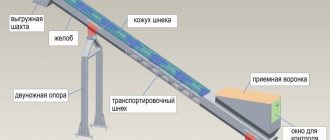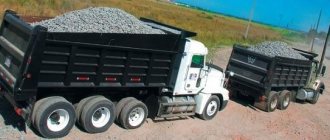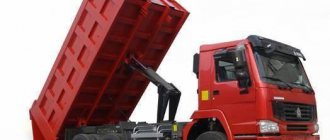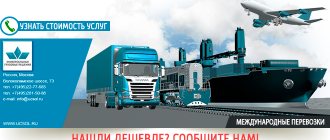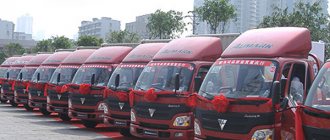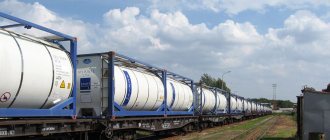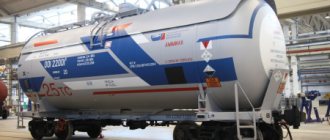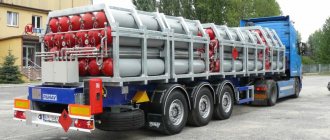The new edition of the “Rules for the Transportation of Goods” brought carriers electronic document management and additions to the waybill. What else has changed and what does the tax authorities have to do with it? Read in the article:
2021 is generous with innovations and changes. Requirements for carriers and the list of rules they must comply with are traditionally growing. Some of the most global ones are the abolition of UTII and the subsequent change of the tax regime, changes in the rules for filling out the waybill, and changes in the rules for calculating the driver’s working time. Don’t forget about the new inspection procedure, which will come into effect on October 1, 2021, and the closure of the Moscow Ring Road for transit trucks. But that's not all.
On January 1, 2022, a new edition of the Rules for the transportation of goods by road came into force. This document is fundamental in the work of carriers. Ati.su looked at the key changes that carriers will have to face. According to the authors, these innovations will make the work of drivers, logisticians and... suddenly, tax inspectors easier. They were prompted to this conclusion by the explanatory note to the bill published last summer, which noted that the new rules regulate electronic document management, will soften the requirements for individual documents and will help in the implementation of the so-called “regulatory guillotine.”
Features of transportation by refrigerators
Read
Cargo can be transported if the following requirements are met:
- if the likelihood of things falling out of the body (van) is minimized, i.e. the cargo is stowed in accordance with all rules and securely secured;
- if the transported cargo does not interfere with the driver;
- if all identification marks, headlights, brake lights, turn signals are open;
- if the load in motion does not make loud sounds that cover the sound of the machine itself;
- if a vehicle with a load in motion does not pollute the road and surrounding area.
Transportation of large-sized cargo by road also has its own characteristics. Oversized luggage includes any type of luggage that protrudes beyond the car body by more than 1 meter in front and back, and more than 0.4 meters on the sides.
What important documents are needed for special cases of cargo transportation in Russia?
Sometimes you have to deliver unusual products. Then you need to have official documents with you:
- a certificate according to which the company is allowed to transport large, dangerous and other unusual shipments;
- a certificate, from which it is clear that the driver has undergone special training and can engage in transportation, and has also worked and received driving experience for more than 3 years without interruption of activity;
- a certificate that indicates the safety of the product and confirms the properties of the container;
- insignia for unusual goods;
- evidence that the vehicle was prepared to perform the tasks;
- route with a specified delivery permit period;
- Full name, addresses, telephone numbers of all persons who are related to the process of sending a specific batch;
- waybill, which contains the hazard number in accordance with all UN requirements.
If the batch is too large or unusual in size, or very different from the usual ones, then you will have to obtain permission for this. Otherwise it won't be possible to move on the roads. To obtain such a certificate you will have to pay a state fee.
To load classified documents, you need to follow other rules. The fact is that their design, creation of copies - all this requires more complex mechanisms and knowledge compared to ordinary files. To send such forms, it is necessary to ensure complete safety of the vehicle and comply with all safety and delivery conditions. The driver should be trained in accordance with the latest requirements.
What responsibility does the carrier bear for loss, damage or shortage of cargo?
The carrier is responsible for the safety of the cargo from the moment it is accepted until it is transferred to the addressee (recipient). The carrier is not responsible in cases where damage or loss occurs due to reasons beyond its control.
If the loss or damage occurred due to the fault of the carrier, then he is obliged to compensate the full or partial cost (depending on the degree of damage suffered by the owner or recipient of the cargo).
The cost is determined based on the price indicated on the seller's invoice and/or contract. If no price is stated in these documents, the value is determined on the basis of the price charged for similar goods under comparable circumstances.
In addition to compensation for damaged or lost cargo, the carrier is obliged to return to customers (sender or recipient) the transportation fee if it was paid in advance.
If the carrier independently compiled documents on the reasons why the loss or damage of the cargo occurred, then in the event of a conflict situation with the owner (sender) of the cargo, they can be challenged in court.
Ready-made solutions for all areas
Stores
Mobility, accuracy and speed of counting goods on the sales floor and in the warehouse will allow you not to lose days of sales during inventory and when receiving goods.
To learn more
Warehouses
Speed up your warehouse employees' work with mobile automation. Eliminate errors in receiving, shipping, inventory and movement of goods forever.
To learn more
Marking
Mandatory labeling of goods is an opportunity for each organization to 100% exclude the acceptance of counterfeit goods into its warehouse and track the supply chain from the manufacturer.
To learn more
E-commerce
Speed, accuracy of acceptance and shipment of goods in the warehouse is the cornerstone in the E-commerce business. Start using modern, more efficient mobile tools.
To learn more
Institutions
Increase the accuracy of accounting for the organization’s property, the level of control over the safety and movement of each item. Mobile accounting will reduce the likelihood of theft and natural losses.
To learn more
Production
Increase the efficiency of your manufacturing enterprise by introducing mobile automation for inventory accounting.
To learn more
RFID
The first ready-made solution in Russia for tracking goods using RFID tags at each stage of the supply chain.
To learn more
EGAIS
Eliminate errors in comparing and reading excise duty stamps for alcoholic beverages using mobile accounting tools.
To learn more
Certification for partners
Obtaining certified Cleverence partner status will allow your company to reach a new level of problem solving at your clients’ enterprises.
To learn more
Inventory
Use modern mobile tools to carry out product inventory. Increase the speed and accuracy of your business process.
To learn more
Mobile automation
Use modern mobile tools to account for goods and fixed assets in your enterprise. Completely abandon accounting “on paper”.
Learn more Show all automation solutions
Fines
The peculiarities of road transport of goods are such that if a driver grossly violates the rules during transportation, he will face administrative liability in the form of a fine.
Types of violations and fine amounts
For violation of transportation rules during icy conditions, the fine can be no more than 500 rubles.
Violation of the rules for transporting heavy cargo may result in either a fine of 2.5 thousand rubles or deprivation of rights for up to 6 months. If the driver is an official, then the size of the sanction increases to 15 thousand rubles, and for a legal entity - up to 500 thousand.
If the weight of a heavy load is more than 5% higher than what is indicated in the documents, then the fine can range from 1 to 250 thousand rubles.
If the dimensions of large cargo exceed the dimensions by more than 1/5 or the weight by 20%, then the fine will be 3-4 thousand rubles. For officials, the sanction will be 25–30 thousand rubles, for legal entities – 300 thousand.
Fines are also provided for cases when, when transporting bulk cargo, it spills onto the road.
What are bulk cargoes?
Bulk substances are a homogeneous substance, which is characterized by a certain degree of flowability. Such cargoes are divided into two types:
- Bulk ones that pour out without outside help.
- Bulk. Special mechanisms are used for unloading.
In general, the following materials can be classified as bulk cargo:
- salt;
- sugar;
- expanded clay;
- coal;
- priming;
- corn;
- various fertilizers;
- crushed stone;
- sand, etc.
Types of bulk cargo
The process of transporting this kind of material is not just delivery from point A to point B. There are certain rules for transportation, which we will talk about in a little more detail.
Features of organizing cargo transportation
The procedure for transporting various goods by road:
- a contract for the carriage or chartering of a vehicle for transportation is concluded;
- vehicles and containers are provided, loading is carried out;
- the weight of the cargo is determined, the body and containers are sealed;
- cargo is delivered, the body is unloaded and cleaned;
- acts and other documents are drawn up, and if necessary, claims are filed.
A permit for the transportation of heavy cargo is not required if the total weight of the cargo with the machine exceeds the permissible values by no more than 2%. If the excess is 2–10%, then the permit is issued in a simplified manner.
Important! You cannot transport such types of cargo as heavy and bulky that can be divided into parts. If an object or structure can be disassembled into parts without damaging its basic technical and operational properties, then it must be transported in separate parts.
The exception is those cases when the excess of permissible values is no more than 2%. But even in this case, you must first obtain permission. You also need to keep in mind that in some cases special escort is required to transport such goods.
Despite the fact that the specifics of transporting goods by road seem not at all complicated, this area is part of a large economic industry - logistics. Therefore, there are many rules and requirements, because Without their observance, it is impossible to effectively solve all the assigned tasks.
What else might you need?
Not everything is always limited to basic papers. Sometimes conditions change and then other documentation becomes important:
- vehicle passport, forms confirming timely technical inspection;
- if the owner of the car is not driving, then it is better to take the agreement on the basis of which he is engaged in delivery;
- invoice - when the consignment note does not contain all the information about what is inside;
- if they are bringing something edible, it is recommended to have a health passport;
- veterinary passport - if transporting live animals, meat, offal;
- for the legal transportation of alcohol-containing products, appropriate licenses and certificates will be required;
- the contract in accordance with which the actual shipment took place;
- confirmation of compulsory insurance of the vehicle owner;
- a certificate that confirms the acceptable quality of products;
- if everything moves in a reefer, you will need information about how the temperature in the body is maintained and monitored.
It remains to understand what documents are needed to transport cargo. In each specific case, other papers may appear, which also need to be completed in a timely manner and taken with you on the journey. Sometimes, without them, responsible persons are subject to fines for non-compliance with laws, because the manufacture of some types of products has its own characteristics. And sometimes this ends in clarifications with the competent authorities. Therefore, before the first transportation, you should consult with lawyers about what else you may need if the car is stopped for inspection.
And now we propose to examine some of the above points in more detail to understand what they should look like.
Preparation of correct documents for the correct transportation of goods for a truck driver: passport of the equipped vehicle
Paper you can't leave the garage without. It contains maximum information about the car, its make, model and year of manufacture. The owner who is responsible for it is listed. According to this form, the car has undergone mandatory registration of the vehicle with government agencies. When it is checked by the competent authorities, they can find out everything about the vehicle.
Veterinary passport
In fact, this is documentation that confirms the identity of the animal if dogs, cats, breeding bulls or horses are transported - any livestock that is on the balance sheet of the sending company. It should contain notes about preventive examinations, veterinary registration, all vaccinations and previous diseases. This is especially true for breeds that are valuable to the country and for which international movement is limited. Without a veterinary passport, it is impossible to move to another state or send your beloved dog there.
What does a driver need to transport goods: a product quality certificate
It is worth processing and sending with a carrier, since without it there is no way to legally move, import and sell any controlled food products. Condition checks are provided for children's products, equipment, appliances, everything that is eaten and other objects.
For example, for meat and meat-containing products, you will need to take special paper with you, which will confirm that these are high-quality products and can be eaten. According to it, the item complies with safety standards, technical regulations, GOSTs and standards.
Freight costs
| Loading point | Unloading point | Tent 82 m³ / 20 t | Refrigerator 82 m³ / 20 t |
| Chelyabinsk | Irkutsk | 200 000 | 220 000 |
| Novosibirsk | 95 000 | 115000 | |
| Omsk | 55 000 | 70000 | |
| Krasnoyarsk | 145 000 | 160 000 | |
| Krasnodar | 90 000 | 80 000 | |
| Vladivostok | 420 000 | 450 000 | |
| Saint Petersburg | 80 000 | 75 000 | |
| Chita | 300 000 | 330 000 | |
| Abakan | 160 000 | 180 000 | |
| Krasnokamensk (Trans-Baikal Territory) | 380 000 | ||
| Kazan | 40 000 | ||
| Tyumen | 30 000 | 35 000 | |
| Permian | 30 000 | ||
| Magnitogorsk | 20 000 | ||
| Ust-Kut | 230 000 | ||
| Makhachkala | 115 000 | 130 000 | |
| Grozny | 115 000 | 130 000 | |
| Simferopol | 130 000 | 145 000 | |
| Sochi | 130 000 | 145 000 | |
| Murmansk | 160 000 | 180 000 | |
| Kovdor | 150 000 | 160 000 | |
| Magnitogorsk | Chelyabinsk | 22 000 | |
| Bely Yar | 95 000 | ||
| Ekaterinburg | 30 000 | ||
| Saint Petersburg | Chelyabinsk | 115 000 | 140 000 |
| Ekaterinburg | 115 000 | 135 000 | |
| Tyumen | 125 000 | 140 000 | |
| Permian | 105 000 | 125 000 | |
| Ekaterinburg | Chelyabinsk | 13 000 | 18 000 |
| Saint Petersburg | 80 000 | 75 000 | |
| Tyumen | 35 000 | ||
| Abakan | 160 000 | 180 000 | |
| Krasnodar | 90 000 | 80 000 | |
| Krasnoyarsk | 145 000 | 160 000 | |
| Novosibirsk | 95 000 | ||
| Krasnodar | Chelyabinsk | 110 000 | 135000 |
| Magnitogorsk | 100 000 | 130 000 | |
| Ekaterinburg | 115 000 | 140 000 | |
| Prices are based on a full truck load. Prices for groupage cargo will vary depending on the weight and volume of goods transported. | |||
Traffic safety organization
Transportation of various bulk materials requires special skill and attention from the truck driver, since this cargo is highly mobile. There are some risks along the way:
- luggage may spill onto the road or the roofs of cars passing nearby, thereby creating an emergency situation;
- heavy weight and movement of materials to one side on turns, ascents and descents makes it difficult to control the machine;
- Some goods are subject to heat and may catch fire.
To minimize the possibility of such situations occurring, you need to follow some rules:
- The load must be evenly distributed throughout the body so that it does not spill over the sides.
- Small bulk materials are covered with an awning so that they are not blown onto the road by the wind.
- If the luggage is transported in a container trailer (bulk granular products), it must first be packed.
- Of course, you must comply with all traffic rules that apply to trucks.
- The route is planned in advance, it should only pass along those roads where trucks are allowed to pass.
- The driver must have documents with him for the materials being transported (if he does not have a forwarder-carrier or sales representative with him):
- agreement between the shipper and the recipient;
- agreement with a transport company;
- car rental agreement (if it does not belong to the logistics company that transports the cargo);
- waybill, which contains information about the product.
Transportation of bulk bulk cargo, building materials, products and structures
Most bulk cargo has high fluidity and an increased abrasive effect on the rubbing parts of rolling stock and loading and unloading machines and devices.
Cargoes such as alabaster, gypsum, chalk, cement are highly soilable cargoes; After unloading, the wagons must be washed. In addition, they are binding materials; when mixed with water, they form plastic masses, which then harden.
Cementing materials have increased sprayability.
Powdered fertilizers have negative properties: increased caking ability, hygroscopicity, dusting, abrasiveness. This necessitates the protection of rubbing parts of machines and rolling stock, the use of respirators to protect the respiratory organs of operating personnel and the adoption of measures to
preventing qualitative and quantitative losses of fertilizers. Granulation allows you to change or significantly weaken the negative physical and chemical properties of fertilizers.
The list of goods allowed for transportation in bulk, on the basis of Article 23 of the Charter, is established by the Ministry of Transport and Communications of the Republic of Kazakhstan.
Bulk cargoes, the size of granules of which does not exceed 13 mm, as well as cargoes of the 0-100 mm class with a particle content (less than 13 mm in size) of more than 50% are classified as cargo of small fractions.
Bulk and bulk cargo are massive and characterized by constant flows. Their loading and unloading is mainly concentrated at large enterprises, which creates mainly favorable opportunities for the transportation of these goods from
Tel routes.
The conditions for the transportation of bulk and bulk cargo are set out in the Rules for the transportation of bulk and bulk cargo by rail.
Cargoes that require protection from precipitation and spraying (for example, cement, mineral fertilizers, apatite, gypsum, chalk) are transported in bulk in hopper cars (cement tankers, mineral trucks, apatite trucks) and in other specialized covered cars. Cargoes that do not require protection from atmospheric precipitation (for example, ore, coal, fluxes, sand, crushed stone, gravel, peat, slag) are transported in bulk in open railway rolling stock and in specialized wagons.
When preparing transportation documents for the transportation of bulk cargo in specialized wagons and solid-bottomed gondola cars, the shipper is obliged to make a note in the consignment note in the column “Special statements and notes of the sender” with the following content: “Transportation in specialized wagons (or, accordingly, in solid-bottomed gondola cars) has been agreed upon with the recipient. Unloading devices are available."
Cargoes transported in bulk and requiring protection from precipitation and pollution (for example, melons, vegetables and others) are transported in covered wagons. Cargo transported in bulk that does not require protection from precipitation (for example, firewood, natural stones, ferrous metals) is transported in open rolling stock and in specialized wagons.
Transportation of cargo in bulk in covered wagons is permitted only with door barriers installed by the shipper. To block the doorways of cars, shields, boards, slabs, barriers made of other dense materials, as well as barriers can be used.
containerized cargo.
When preparing transportation documents for the transportation of cargo in bulk or in bulk, the consignor indicates “bulk” or “bulk” in the consignment note in the “Number of pieces” column, respectively.
After unloading of many cargoes transported in bulk or bulk, the wagons must be washed. The list of these cargoes is given in the Rules for cleaning and washing wagons and containers after unloading cargo. Loads transported in bulk and in bulk are weighed as
as a rule, on carriage scales without uncoupling the carriages, but stopping them at the weighing platform. The container weight is usually taken according to a stencil.
The mass of bulk and bulk cargo can be determined by measurement. Bulk bulk and bulk cargo, as a rule, are presented for transportation in groups of wagons (group or route shipments) and can be issued using one consignment note form GU-27e.
transportation of hard coal constitutes a significant part of freight turnover by rail. In the structure of cargo loading on the railways of the Republic of Kazakhstan, coal
makes up more than one third and is the most massive cargo.
Coal is transported in gondola cars. They must be in good working order and have gaps in the unloading hatches no more than those allowed by technical conditions. Gondola cars supplied for loading coking coal must be free of litter and sand. Before loading fine coal, the shipper is obliged to make sure that transportation in this gondola car will not cause losses or pollution of the railway track and the environment. To achieve this, the shipper takes additional measures to seal the gaps of the gondola car body.
Loaded cars are weighed and, in accordance with the carrying capacity of the gondola car, are loaded or loaded when it is exceeded, i.e. dosage is made. Many mines use bunker loading and weighing devices, on which weighing
fits with loading and no dosage is required.
When transporting and storing coal, it is necessary to take into account such properties as spontaneous combustion, freezing, and crushing. Fossil coals have the ability to absorb oxygen from the air, which leads to self-heating and spontaneous combustion. As oxidation occurs, heat is released and accumulated, which ultimately leads to spontaneous combustion of the coals. It is not allowed to load fossil coals into wagons clogged with the remains of other cargo, since coal dust with other substances (sulfur pyrites, ammonium nitrate, bertholite salt, etc.) forms explosive mixtures.
The grade of hard coal is indicated by the shipper in the consignment note in the column “Name of the cargo”, for example, grade “K” hard coal is coke coal.
Coke is transported in specialized gondola cars for coke with a body volume of 117 m3 or in universal gondola cars with a triangular-shaped “cap”. In shipping documents, the shipper indicates the class of coke, for example, “blast coke,” “fine coke,” “nut coke.” The coke is small and the nut is susceptible to freezing. A significant portion of coke is transported along circular routes.
Peat is transported over short distances. Since the volumetric mass of peat varies widely from 0.2 t/m3 (for an air-dry product) to 0.65 t/m3 (for a wet product), it is transported in specialized all-metal gondola hopper cars with a body volume of 120 m3 and a loading capacity of 58 t or in universal gondola cars with extended sides. To transport peat, peat “turntables” are created from such wagons. When transporting peat, the consignor, along with the consignment note, presents a quality certificate indicating the type, density, moisture content and ash content of the peat. The mass of peat is determined by weighing it on a carriage scale or by measuring it. During long-term storage, peat is susceptible to self-heating and spontaneous combustion.
Ore cargoes are presented for transportation in the form of raw ore (sorted, run-of-mine and fines), ore concentrates, sinter (hot and cooled) and metal pellets. The bulk of iron ore is transported in gondola cars, over short distances - in dump cars, and only a small part - on platforms. Transportation conditions are affected by bulk density, humidity, particle size distribution, porosity, abrasiveness, corrosive and other specific features of ore cargo.
The volumetric mass of ore cargo varies widely and affects the degree of use of rolling stock and loading and unloading mechanisms.
Sinter and pellets are products of special heat treatment of fine ore raw materials and concentrates (sintering of fine ore and concentrates into pieces and balls of a certain diameter). The agglomerate is transported over short distances (300–400 km) in special
cialized metal hoppers (sinter hoppers) in a hot state (up to 700 °C).
Since iron ore, sinter, pellets, and fluxes are sent from a limited number of points and unloaded at points of mass consumption, their transportation is organized primarily along shipping routes. In some directions, ring routes are used for this transportation.
Cement is a binding building material. It is a powder, usually gray-white in color, with caking, arching and atomizing properties.
The transportation documents indicate the type and brand of cement. Due to easy sprayability and harmful effects on the human body, operating personnel should use protective gauze bandages or respirators when working with cement. Cement is transported in bulk in universal covered wagons, in specialized self-unloading covered wagons, in specialized cement tanks and in special shipper containers. In specialized wagons, cement is delivered to consignees who have unloading devices; other consignees have such
the carriages are sent with their consent. Cement is also transported in containers; Kraft paper bags with a capacity of 50-70 kg are used as containers for cement. The shipper places a label in each car with cement - a preliminary passport, which is the primary technical document certifying the grade and brand of cement. Then the final passport is sent to the consignee, using which he can verify that the cement he needs has arrived at his address.
Bricks are transported in covered and open rolling stock and in specialized containers, as well as in packaged form. When loading onto platforms, bricks are laid above the sides. It is most rational to transport bricks on pallets and lay them in a semi-parquet manner.
Mineral fertilizers are transported and stored mainly in packaged form or in bulk. Fertilizers are packed in plastic and paper bags weighing up to 50 kg. Contained fertilizers are transported in universal covered wagons. For transportation of fertilizers in bulk, use
They use specialized covered all-metal bunker-type wagons (mineral hoppers) with body volumes of 73.0 and 81.0 m3, as well as specialized rigid, semi-rigid and soft containers. All points for loading mineral fertilizers into mineral carriages must be equipped with dosing devices. When unloading a mineral tanker, the formation of a vacuum inside the body must not be allowed. For this purpose, one of the loading hatches on the roof is opened before unloading. Mineral fertilizers are unloaded from mineral carriers onto both sides of the elevated track or into special receiving devices.
To freezing loads
These include cargo transported in bulk, which, at outside temperatures below 0 °C, lose their usual flowability properties due to the freezing of cargo particles among themselves and their freezing to the floor and walls of the car body. The list of cargo transported in bulk, classified as freezing cargo, as well as the timing of preventive measures against freezing during the cold period of the year, depending on the location of the carrier’s departments, is given in Appendices 1 and 2 of the Rules for the transportation of frozen goods by rail.
The rules for the transportation of frozen goods by rail provide for the procedure and conditions for the application of preventive measures and means of restoring the flowability of goods and the registration of their transportation. Before the onset of the cold period of the year, during which the use of preventive measures to prevent freezing of cargo is mandatory, shippers and consignees must carry out appropriate preparations. First of all, stocks of preventive means are created at the loading points of frozen goods, repairs are carried out on installations for carrying out preventive maintenance of bulk cargo and car bodies during loading, as well as mechanisms and devices for restoring the flowability of frozen goods at unloading points. The carrier has the right to selectively check at loading points the consignor’s compliance with the rules for preparing frozen goods and rolling stock for transportation.
Before presenting cargo susceptible to freezing for transportation, the shipper must take measures to reduce their moisture content to safe limits established by GOST and technical specifications for products. If this is not possible, the shipper applies preventive measures. In cases where the applied preventive measures were not effective enough, the consignee is obliged to take measures to restore the flowability of the cargo at the unloading point.
An effective means of protecting cargo from freezing during persistent frosts is preliminary freezing by repeated pouring (shovelling). Other precautions include refilling the cargo with quicklime,
sawdust, calcium chloride, table salt, uniformly spraying their mass, as well as the floor and walls of gondola cars and platforms with coal and mineral oils, preventive liquids - niogrine and severin, solutions of chloride
calcium and table salt.
Adding the necessary preventive agents to the mass of cargo, including coating the walls and floors of gondola cars and platforms with liquids and solutions, must be carried out in a way (mainly mechanized) that ensures uniform mixing of these
products with bulk cargo, uniform layer-by-layer pouring, thorough spraying with oils, niogrine, severin.
The choice of preventive measures by the shipper depends on the type of cargo, unloading technology and subsequent use or processing of the cargo by the consumer. The selected means of prevention should not adversely affect the rolling stock, as well as the quality and properties of the transported cargo, provided for by the relevant GOST or technical specifications for the products. The means of prevention chosen by the consignor are agreed upon with the consignee.
Preventive measures to protect bulk types of cargo transported in bulk from freezing are given in Appendix 3 of the Rules for the transportation of frozen goods by rail.
At loading points, shippers must have persons responsible for implementing preventative measures against freezing.
During long-distance transportation of goods in conditions of low ambient temperatures, changing climatic and meteorological conditions (especially during transitional periods of the year), consignees equip their unloading points for frozen goods with means of heating or mechanical loosening to restore the flowability of these goods. To warm frozen cargo, hot houses and other heating devices (for example, infrared emitters) are used. For mechanical loosening of such cargo, drilling and milling installations, self-propelled vibroimpact installations, vibratory rippers of various types, and excavator-type installations are used.
When presenting freezing cargo for transportation, the consignor indicates in the consignment note in the column “Special statements and notes of the consignor” the percentage of moisture content of the cargo and the measures taken to protect it from freezing. For example, “The cargo is frozen”, “Sprinkled with lime in the amount of ...%”, “Oiled in the amount of ...%”, etc. In addition, the shipper is obliged to put the “Frozen” stamp at the top of the consignment note.
It is not necessary to indicate moisture content in the consignment note when loading earth, clay, sand, crushed stone and gravel. The carrier may accept frozen cargo for transportation without applying preventive measures if the consignor has the written consent of the consignee to accept the cargo transported under such conditions and ensure its timely unloading. In this case, the shipper makes a statement in the consignment note.
In the event of the arrival of cargo in a frozen state, which occurred as a result of the consignor’s violation of preventive measures or the terms of shipment of frozen goods agreed upon with the consignee in the delivery agreement, the consignee shall, with the participation of
of the carrier's representative, a general form of act. The act confirms the fact of the arrival of the cargo in a frozen state, and also indicates the amount of payment made by the consignee for the use of wagons for the period of time associated with the unloading of such cargo.
When transporting bulk cargo, the shipper is obliged to take measures to prevent loss of cargo, pollution of the environment and the railway track.
All losses can be divided into three types: leakage of cargo into structural gaps and leaks in the car body; blowing out small fractions with an air flow flowing around a moving train; shedding of cargo placed above the sides. These losses increase as the train speed increases.
When transporting fine coal, coke breeze, concentrates of ferrous and non-ferrous metal ores, mineral fertilizers and peat, losses vary from 1.5 to 5.5 tons per car. In addition to material damage, when cargo is lost, the railway track and the environment are polluted.
Contamination of ballast with non-ferrous metal ore concentrates and iron ore concentrates disrupts the reliable operation of electrical rail circuits and automatic blocking, causing delays in train movement. The penetration of dust-like particles, which are abrasive, into the moving parts of rolling stock causes its premature wear and failure. As a result of track contamination, unsanitary conditions are created for passengers and labor protection requirements for workers associated with train traffic are violated. It is possible to avoid or minimize losses of bulk cargo by improving, containerization and packaging of transportation, and the widespread use of specialized rolling stock (mineral hoppers, cement tankers, special tanks).
When transporting bulk cargo in open rolling stock, the shipper is obliged to take all necessary measures to prevent the blowing out of small particles during transportation, cargo leakage and shedding during loading with a “cap”.
To prevent cargo from leaking into structural gaps and leaks in car bodies, cracks and gaps are sealed using rolled, sheet and film materials, pastes and mastics, and compacted using binders and long-fiber fillers. Sealing materials are prepared and applied to the cracks and gaps of the car body before loading using a special installation.
To prevent the load from blowing out, it is necessary to level its surface and, if necessary, compact it. Lightweight cargo of small fractions (volume weight less than 0.85 t/m3) is loaded into gondola cars so that the upper part of the stack (“cap”) is well leveled and after compaction the height is 250-300 mm. In cross section, the “cap” of the load is given the shape of a trapezoid: its base should be 50 mm below the level of the top trim of the sides of the gondola car. The base of the “cap” of mineral construction cargo should also be 50 mm lower than the level of the top trim of the sides of the car, and its height should not exceed 750 mm.
Depending on the particle size distribution and density of the cargo of fine fractions, the following devices are used to level and compact its surface: guide cargo flow dividers under the outlet of the bunker and scraper levelers (concentrates of ferrous and non-ferrous metal ores, etc.); installation of static action at
volumetric mass of cargo 0.85-1.0 t/m3 (Fig. 7.24), installation of vibrostatic action with volumetric mass of cargo less than 0.85 t/m3, overhead vibrators for small-sized lightweight cargo (coke, peat and lignite briquettes), etc. .
Rice. 7.24. Installation of static action for leveling and compacting coal in gondola cars: 1
— lifting mechanism;
2
- frame;
3
- locking device;
4
— compactor roller
Rice. 7.25. Applying a film-forming solution to the surface of cargo loaded above the level of the sides of the gondola car: 1
- carriages;
2
- pump;
3
— winch;
4
- spray nozzles;
5
— compactor roller;
6
- carriage scales
The most effective way to protect cargo of small fractions from blowing out is to cover their surface with protective films obtained from cheap chemical production waste with astringent properties. The protective film must be strong, elastic, provide good adhesion to the perimeter skin of the car body and to cargo particles, and not be destroyed at high speeds.
The film is applied to the leveled and compacted surface of the load as the car moves under the spray nozzles (Fig. 7.25).
By covering the load with protective films, losses from blowing are completely prevented.
Safety precautions
Heads of railway stations, cargo areas, heads and foremen of production areas, acceptance and delivery personnel in their work are guided by the Fundamentals of the legislation of the Republic of Kazakhstan on labor protection, the Regulations on the organization of work on labor protection in railway transport, instructions of the Ministry of Labor and Transport of the Republic of Kazakhstan, orders of the head of the road and local instructions and rules on equipment safety, as well as industry safety standards.
At each cargo point, those responsible for the safe performance of work (foremen, exempt foremen or acceptance workers) are appointed.
The procedure for briefing, training and testing knowledge on labor protection of workers in mechanized loading and unloading operations and commercial operations and the cargo area is regulated by the instructions of the Ministry of Labor and Transport of the Republic of Kazakhstan. The results of briefings and inspections are recorded in journal entries in the prescribed form.
Persons at least 18 years of age who have undergone a medical examination, trained in safe labor methods and tested in knowledge of current norms, rules and instructions on labor protection are allowed to perform loading and unloading operations. On production
In areas, safety corners are created with visual materials, albums and posters on safety precautions and safe work practices.
Station heads, together with the heads of production areas and heads of cargo areas, develop schemes for the safe passage of workers through the tracks of stations and the cargo area, as well as routes for the passage of vehicles. The diagrams must be brought to the attention of each employee, and signs must be posted along all passage routes.
At the loading and unloading sites, heating points, rest rooms, meals, changing rooms, showers and washbasins, facilities for washing, cleaning and drying work clothes and work shoes are installed. There should always be cooled boiled water for drinking. In all these
In places, the addresses and telephone numbers of the nearest medical centers are posted.
In office premises there should be first aid kits with instructions on providing first aid to victims. The receiver must be able to provide first aid to victims.
In winter conditions, special measures are taken at loading and unloading sites to prevent injuries and ensure normal working conditions: clearing entrances, passages, crane runs, workplaces from snow and ice, sprinkling with sand, etc.
Workers in the cargo area must be provided with special clothing and personal protective equipment when performing work with special cargo, dusty and toxic cargo, or in conditions deviating from the normal working environment.
Loading, unloading, reloading of wagons and vehicles at stations and non-public railway tracks is permitted only under the direction of the person responsible for these works.
The cargo acceptance manager supervises the work of teams of loaders and machine operators, determines the order and sequence of cargo operations, monitors compliance with clearances during unloading, installation of ladders, walkways, proper stowage of cargo, cleaning of passages and driveways from foreign objects, debris, ice and snow, etc. d. He is obliged to ensure that the paths on which loading and unloading operations are carried out in public areas are fencing with portable signals, and to prevent unauthorized persons from being present at the work sites.
The safety requirements for the cargo acceptor are specified in the Job Description of the cargo acceptor, which, in addition to general instructions, provides instructions on the contents of the workplace, safety measures when on the railway tracks, electrical safety measures, general safety requirements when performing loading and unloading operations using carrier means, requirements safety precautions when loading and unloading dangerous goods, when working at a container point, etc.
Loading and unloading of wagons is permitted only after they have been secured and fenced with portable signals on the tracks on which loading and unloading operations are carried out.
Loading and unloading operations during maneuvers are not allowed. When moving wagons at the loading and unloading points, the receiver is obliged to warn all workers about the procedure for performing the work, ensure that the transition bridges and other devices are removed, the loaded cargo in the wagons is secured, and the wagon doors are closed before it begins to move.
The movement of cars at loading and unloading points by hand is allowed in exceptional cases only on a horizontal section of the track in the amount of no more than one loaded or two empty cars under the direct supervision of a responsible person designated by the head of the station or cargo area.
Manual movement of wagons occupied by people and dangerous goods is prohibited.
During loading and unloading operations, people are not allowed to be in the operating area of lifting mechanisms, as well as in gondola cars and cars.
It is prohibited to stack cargo in weak packaging that cannot withstand the load from the top rows, and cargo that has an irregular shape that does not ensure the stability of the stack.
To prevent injuries during loading and unloading operations, it is prohibited to accept cargo for transportation if there are protruding nails, unbent ends of wire, strapping tape and other sharp protruding fasteners of the box parts on the boxes and other packaging areas.
When performing operations to seal wagons and containers, the receiver must make sure that there are no moving locomotives and wagons on the approaches; When filling, use only serviceable seals, and when removing them, use serviceable pliers.
When opening doors in covered wagons, acceptance officers must ensure that they are hung on the crossbar. To prevent the load from falling onto the worker from the carriage, the covered carriage should only be opened and closed using the door handrail and must be behind its panel. It is prohibited to rest your hands on the door frame or walls of the carriage. When opening a door, workers must pull it towards themselves, and when closing it, only away from themselves. When opening the side of the platform or the hatch of a gondola car, the worker must stand aside at a distance of at least 1 m from it. The hatches of gondola cars are closed with hatch lifters, and in the absence of them, this is done by a team of three workers. When opening the doors of cars, hatches of gondola cars, the sides of platforms, cutting off the tie-down wire, or removing racks, the receiver and workers are not allowed to be in the area of a possible falling load.
To avoid the collapse of the cargo, it is prohibited to take the cargo from the car or stack from below.
When loading and unloading boxes, bales or bales, you must pay attention to their packaging. Poor or damaged packaging, protruding nails, ends of wire, steel strips and other sharp objects can injure your hands. Therefore, when handling goods, workers are required to wear gloves.
The maximum norm for carrying loads manually on a horizontal surface per person should not exceed the established standards (no more than 50 kg, moving a distance of 60 m, lifting to a height of no more than 3 m). Cargo items from 50 to 100 kg must be moved on trolleys, and over 100 and up to 1500 kg - on small-sized loaders.
Roll-barrel loads are usually moved by rolling. It is advisable to transport small loads on trolleys, since when rolling you need to bend low, which quickly tires workers. Rolls and barrels roll along the horizontal floor in front of them. At the same time, you should not hold the drum ends or the end of the roll with your hands, as you can injure your hands on a pole, stack, or car door pillar. On an inclined plane, loads are rolled along paired slats using a rope. Workers helping from below must be on the sides of the bed. Barrels weighing up to 35 kg are allowed to be rolled without ropes. Compressed gas cylinders are moved on special trolleys with rubber wheels or on stretchers. Carrying on shoulders is prohibited.
Loading and unloading areas must be equipped with lighting (explosion-proof if necessary), ensuring work can be carried out around the clock, and also be equipped with fire-fighting equipment.
In places where flammable liquids are filled and discharged that are not equipped with electric lighting, only electric explosion-proof lamps are allowed to be used as lighting devices.
The supply for loading and unloading and removal of railway tanks must be carried out smoothly, without jolts or jerks. The movement of shunting diesel locomotives along railway tracks on which loading and unloading devices are located is prohibited. Any movement of tanks on racks must be agreed upon with the operator of the loading and unloading area.
It is prohibited for steam cleaners to descend into the boiler of tanks containing: leaded gasoline that has not undergone treatment and degassing; with the remains of an unspecified cargo; the remainder of any cargo more than 10 cm deep; no permanent staircase; without provision
according to the standards of special clothing and special footwear, as well as without rescue equipment and a hose breathing apparatus or other respiratory protection equipment; without a second washer-steamer at the tank caps; with open fire, with a non-explosive flashlight.
Before starting work, the washer-steamer, together with the foreman or foreman, must ensure that hose breathing devices or other respiratory protection equipment with an active air supply, rescue equipment and tools are in good condition, and also check the length of the hose, the tightness of the mask to the face, and the absence of damage to the mask and a hose. The breathing test while wearing a mask should last at least 3 minutes. In addition to routine inspection, the hose breathing apparatus must be
undergo a leak test. It is prohibited to descend into tanks containing caustic and poisonous substances, as well as gasoline, crude oil and all other liquids that emit harmful vapors without a hose and rescue belt. A rope is secured to the safety belt, the opposite end of which goes out through the tank hatch. Outside the hatch there should be an auxiliary worker equipped with a spare hose gas mask in case it is necessary to descend into the tank to assist the person working in it. An auxiliary worker holds the end of the rope, monitors the well-being of the washer working in the tank, and monitors the position of the air hose.
When cleaning tanks after draining toxic cargo, it is necessary to wear special protective clothing (pneumatic suit), which completely protects the worker from penetration of liquid products onto the skin, as well as from overheating and cooling of the body due to sudden
temperature changes, especially in winter.
During an internal inspection, only explosion-proof battery-powered miner-type flashlights or lamps with hermetically sealed contacts are used to illuminate the tank. These devices may only be turned on and off outside the tank. Workers going down inside the tank are prohibited from wearing shoes lined with iron nails, hairpins, or horseshoes. When working inside the tank, it is not permitted to use iron or steel shovels, brushes, buckets or similar tools. All this must be made from non-sparking
metals (aluminum, copper) or wood.
When filling and draining tanks, workers should stand on the windward side. Open and close hatches and hood covers with a non-sparking tool.
Before starting work, workers loading and unloading leaded gasoline must be familiar with its properties, instructed in safety precautions when working with leaded gasoline, and provided with appropriate protective clothing.
To ensure safety when transporting petroleum products in tanks and to prevent vacuum in them during transportation, loading and draining, safety inlet valves are installed on the tank cap to regulate the pressure in the boiler.
Calculation of machine needs
Determining the required type of transport occurs at the first, preparatory stage, this was already mentioned a little earlier. In this case, we will talk about calculating the needs of cars.
Sometimes, in order to carry out fast and high-quality transportation, you may need the service of several vehicles capable of delivering the required amount of cargo to a construction site at periodic intervals.
Read about transporting children on a motorcycle here.
Another situation involves the opposite requirements, for example, the rapid transportation of crops from a warehouse to another facility. Therefore, each situation must be approached with a full analysis of what is happening, taking into account not only financial criteria, but also the properties of the material.
Loading and unloading robots
These processes are carried out in designated areas, strictly observing safety rules. The sites should be located away from residential areas, industries and any places where people may be. To work with hazardous materials, forklifts use protective suits and specialized equipment that allow the process to be carried out without the occurrence of force majeure situations. Only personnel who have undergone special training are allowed to handle hazardous materials.
To send this type of bulk cargo, platforms and wagons made of a special alloy are used. The goods must be supervised throughout the entire journey to eliminate any possibility of emergency situations.
Excavation work must be carried out under the supervision of specialists
Multimodal bulk transportation
This transportation of bulk materials involves the use of several types of vehicles (rail, sea, air), on the basis of a general agreement. This also includes reloading from one vehicle to another, using platforms specially equipped for this.
Organizing multimodal bulk transport is not easy. This process requires good management skills, not forgetting technology. The interests and capabilities of customers, transport and warehouse organizations together with the requirements of customs brokers are taken into account.
The process of multimodal shipments requires a serious approach to the choice of transport for work without losses. Regarding international deliveries, it is better to opt for sea transport. It is less expensive and convenient for moving objects of all types, sizes and shapes.
Motor transport for multimodal movements is used when sending a small volume of materials over a short distance.
Bulk luggage of low value is often sent by rail without crossing the country's border. The distance from the departure point to the final point is at least 2000 km.
The basis of multimodal shipments is the organization of joint work of several modes of transport, and the more participants in a given chain, the more difficult the management process will be. The contractor needs to take into account the wishes of each party, prepare documents, coordinate all working issues and mitigate possible risks.
It doesn’t matter how many parties are involved in the shipping process, for the customer everything is carried out according to a single transport document “multimodal bill of lading”, which takes into account the requirements of each of the parties to the contract. All responsibility for delivery falls on the contractor who signed the contract.
Multimodal cargo transportation involves the use of several modes of transport
Organization of transportation of perishable goods
The organization of transportation of perishable goods on an international route or in cities of the Russian Federation does not have any particular differences. Such goods during bulk transportation must be protected from high temperatures or frosts, excessive air humidity, sunlight... The main task when sending bulk perishable goods is to ensure all these conditions, which is impossible without the use of specialized machines. Only they will allow you to maintain a certain temperature or humidity during the journey.
Most often, the organization of transportation of perishable goods to any city in the Russian Federation involves the use of railway transport.
The main goal of any transport company, when sending luggage in bulk or by any other method, is to properly organize its delivery, regardless of size and quantity. To reduce the price of transportation and optimize delivery costs by any means, it is important to choose the optimal route and transport.
Changes in transportation rules
The main changes affected document flow and the driver’s work schedule. So, the main changes:
- If a waybill is offered as the primary accounting documentation, now it must be drawn up in four copies, where the latter is presented to the shipper.
- Now the waybill is filled out differently: in addition to information about the vehicle, it is required to indicate the type of transportation and the products transported. Be sure to register the make, model, and mileage of the car at the beginning and end of the trip. If there is a trailer, its number is also required. It is also necessary to indicate the date of the driver’s last medical examination.
- According to clause VIII of Resolution No. 2200 of December 21, 2020, from 2022, the circulation of documentation is allowed to be carried out in electronic format: technical specifications, accompanying papers, acts and others. Moreover, each completed form must be signed with a qualified digital signature.
- Since 2022, the Code of Administrative Offenses against violations of cargo transportation by trucks and dump trucks has been updated.
- According to the new bills, the driver needs rest after every 4.5 hours of driving, but only when traveling around Russia. In total, a person should rest about 43 hours per week.
Important! As for taxation schemes: UTII is not valid, but participants in transportation using the simplified tax system and PSN are allowed.
Organization of shipment of hazardous bulk materials
Today there is a clear list and classification of hazardous substances that require special attention when transporting in bulk. These types include:
- flammable and explosive substances;
- toxic materials;
- radioactive compounds;
- substances that promote corrosion can cause damage to the skin upon contact or a violent chemical reaction when combined with other substances (air);
- other.
Sending hazardous substances in bulk by road can cause some difficulties that arise at each stage of delivery. To effectively organize such a process, you will need to draw up a large number of related documentation and permits, selecting responsible executors.
Transportation of radioactive cargo is a complex process that requires a large number of permits
